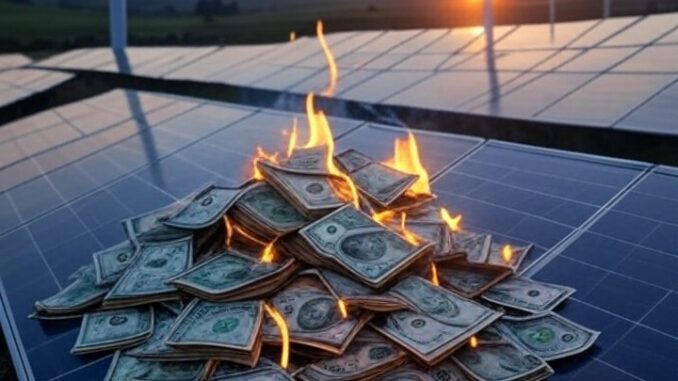
In a move that signals a significant shift in U.S. energy policy, the Trump administration is preparing to implement stricter rules on federal tax credits for renewable energy projects. This development, part of broader efforts to prioritize domestic fossil fuel production, could reshape the landscape of America’s energy sector by curbing subsidies that have long propped up wind, solar, and other green initiatives.
As the administration revises key definitions and eligibility criteria, industry experts anticipate a slowdown in renewable development, potentially benefiting more traditional energy sources like oil and gas.
The Details of the Tightening Measures
The core of these changes revolves around redefining what constitutes a project “under construction” for the purpose of qualifying for tax credits, such as the Investment Tax Credit (ITC) and Production Tax Credit (PTC). Under current rules, developers can secure subsidies by meeting minimal thresholds, like spending 5% of project costs or initiating physical work. The new regulations, expected to raise these bars—possibly to 10-15% of costs and requiring continuous on-site progress—aim to eliminate loopholes and “safe harbors” that have allowed projects to claim credits with limited actual advancement.
Are you from California, New Jersey or New York and need a tax break?
This policy stems from President Trump’s July directive to review and overhaul existing regulations, accelerated by the One Big Beautiful Bill Act (OBBBA). The act phases out clean energy tax credits earlier than previously scheduled, mandating that projects begin construction by July of next year to access the full 30% credit, rather than extending availability through 2032.
Analysts from Clean Energy Associates project a potential loss of up to 60 gigawatts of solar capacity by 2030—enough to power around 10 million homes—if these rules take effect, as developers scramble or stall amid uncertainty.
Globally, this aligns with a broader retreat from aggressive renewable targets. Major players like BP have slashed their green investments from a planned $9 billion annually to just $1.5–$2 billion by 2030, redirecting funds to oil and gas for better profitability.
Similarly, Danish wind giant Orsted is grappling with project cancellations and financial impairments, exacerbated by U.S. policies like the halt on offshore wind leasing under Trump.
These struggles highlight the economic vulnerabilities of renewables without heavy government support.
Impact on Consumer Electricity Prices
While the immediate effects of tightening tax credits may disrupt renewable project pipelines, the long-term implications for consumer electricity prices could be stabilizing or even positive, particularly in a market favoring reliable energy sources. Renewables have often relied on subsidies to remain competitive, artificially lowering development costs but ultimately burdening taxpayers. With reduced incentives, fewer uneconomic projects will proceed, potentially preventing cost overruns from being passed onto ratepayers through higher utility bills.In regions dependent on intermittent sources like solar and wind, the loss of subsidized capacity might lead to short-term price volatility if supply tightens. However, this could be offset by increased reliance on abundant, low-cost natural gas and oil, which provide baseload power without the need for extensive backup systems. For instance, the administration’s push to revoke the EPA’s 2009 endangerment finding on CO2 could dismantle emissions regulations, freeing up fossil fuel operations and potentially lowering production costs.
This deregulation is projected to boost U.S. energy output, helping to keep electricity prices affordable for consumers amid global energy demands. Critics argue that curbing renewables could slow the transition to cheaper clean energy, but evidence suggests otherwise: without subsidies, renewables’ true costs emerge, often higher due to supply chain issues and interest rate pressures seen in cases like Orsted’s $1.7 billion U.S. project impairments.
By contrast, Trump’s “drill, baby, drill” agenda, despite potential hurdles from OBBBA’s tax provisions on foreign firms, aims to enhance domestic supply and competition, which historically drives down prices.
Consumers may benefit from more predictable pricing in a fossil-fuel-dominant grid, avoiding the hidden costs of green mandates.
Investor Perspectives: Favoring Oil and Gas Returns
For investors, these regulatory changes present a clear signal to pivot toward oil and gas, where returns are proving more favorable in the current environment. The tightening of renewable tax credits introduces heightened risk to green portfolios, as developers face financing challenges and project delays. With uncertainty looming, many are accelerating purchases of U.S.-made components to lock in subsidies, but this rush could inflate costs and erode margins.
In contrast, fossil fuels offer stability and profitability. BP’s strategic shift to boost oil and gas spending to $10 billion annually, while cutting renewables, underscores the sector’s resilience, driven by higher oil prices and strong Q2 2025 earnings of $2.4 billion.
Even potential pitfalls in OBBBA, such as increased taxes on foreign operators like Shell and BP (potentially costing them $800 million and $300 million in free cash flow, respectively), may not deter overall investment in U.S. shale and offshore assets, given Trump’s pro-drilling executive orders.
Investors should monitor opportunities in domestic producers, midstream infrastructure, and exploration firms, which stand to gain from deregulation and reduced competition from subsidized renewables. As global renewable goals falter—adding up to 4 billion tonnes of extra U.S. emissions by 2030 under relaxed policies—the oil and gas sector’s fundamentals remain strong, promising higher yields in a policy landscape that prioritizes energy independence over green ideals.
In summary, the Trump administration’s tightening of renewable tax credits marks a pragmatic recalibration of U.S. energy priorities, potentially safeguarding consumer wallets while steering investments toward proven, profitable sectors. As the world grapples with the realities of renewable economics, America’s focus on fossil fuels could ensure a more secure and affordable energy future.
Is Oil & Gas Right for Your Portfolio?
Crude Oil, LNG, Jet Fuel price quote
ENB Top News
ENB
Energy Dashboard
ENB Podcast
ENB Substack







